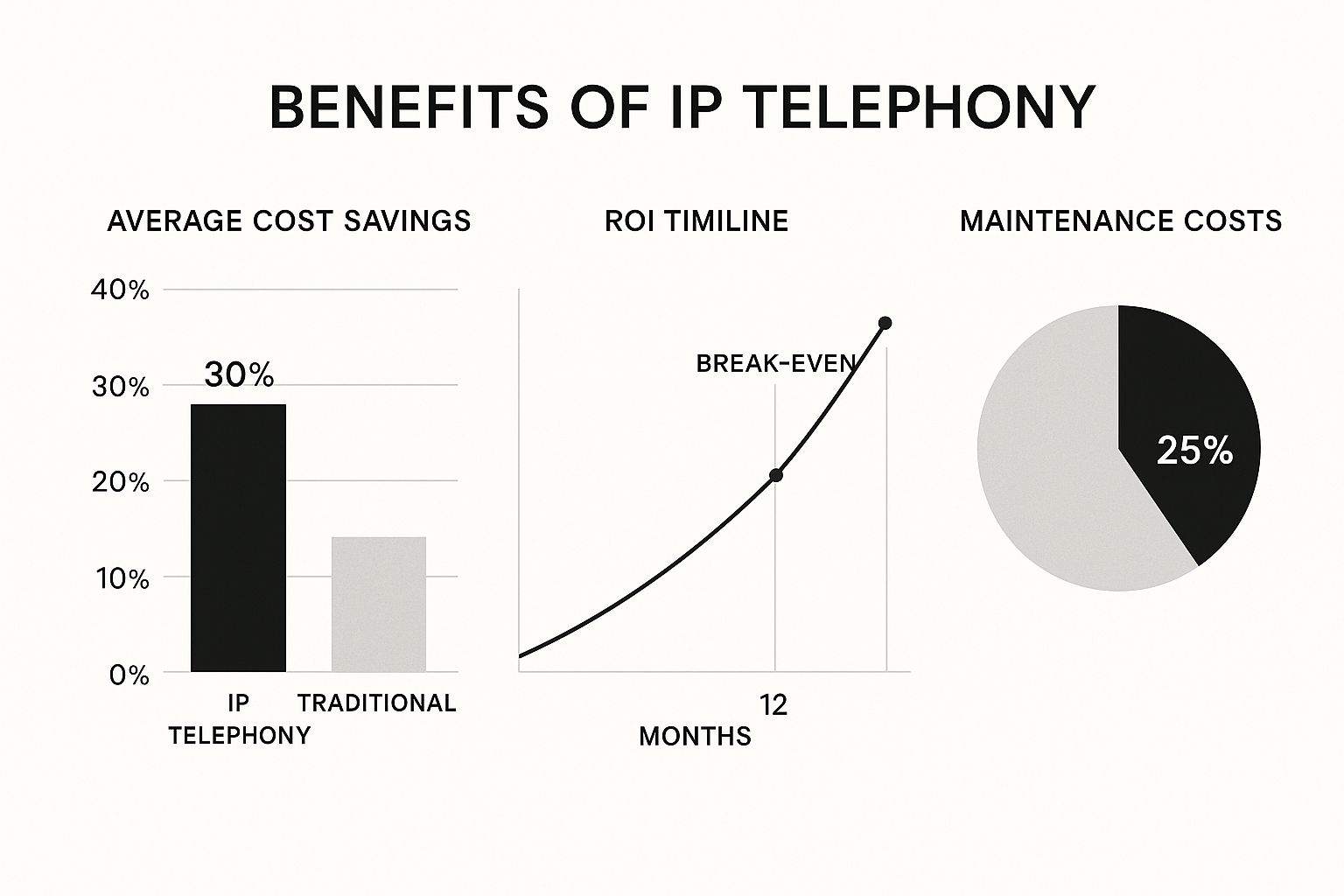IP telephony solutions are business communication systems that transmit voice calls over the internet instead of traditional phone lines. This technology converts your voice into digital data, allowing for more flexible, feature-rich, and cost-effective communication for modern businesses.
Understanding the Core of IP Telephony
Think about the jump from sending physical mail to sending an email. That’s the same kind of leap we’re talking about when moving from traditional landlines to IP telephony. It completely redefines business communication by using your existing internet connection for all your calls, essentially turning your voice into data packets. This simple shift away from old copper wires unlocks a world of advanced capabilities.
Instead of being tethered to a physical phone line at a specific desk, your business phone system becomes as mobile and adaptable as the internet itself. This modern approach gives you a single, powerful hub for every voice interaction, whether your team is in one office or spread across the globe.
How Does It Actually Work?
At its heart, IP telephony runs on a technology you’ve likely heard of: Voice over Internet Protocol, or VoIP. The process behind it is surprisingly straightforward but incredibly powerful.
- Voice to Data Conversion: When you speak into a handset or headset, the system instantly converts the analog sound waves of your voice into digital data packets.
- Internet Transmission: These packets are then sent across your broadband internet connection, traveling the same digital highway as an email or website data.
- Data to Voice Reassembly: On the other end of the line, the packets are put back together in the correct order and converted back into clear audio for the person you're calling.
This entire sequence happens in just milliseconds, so the conversation flows just as clearly—and often even more so—than a traditional phone call. The real magic is how efficiently internet protocols manage this data transfer behind the scenes.
The core principle is simple: your internet connection becomes your phone line. This bypasses the public telephone network, eliminating the need for separate, costly phone wiring and opening the door to integration with other digital tools.
Key Components You Should Know
A few key components work together to bring IP telephony to life. You don’t need to be a tech wizard, but knowing the basics helps demystify how it all fits together. The main elements include VoIP, the foundational technology that makes internet calls possible, and SIP (Session Initiation Protocol), which acts as the signaling language to start, maintain, and end the calls. For a deeper dive into the fundamental concepts of this technology, you might find a comprehensive VoIP guide helpful.
Finally, you have the endpoints—the actual devices your team uses to communicate. These can be:
- IP Phones: These are desk phones that look familiar but are designed to plug directly into an internet connection.
- Softphones: This is just software—an application on a computer or smartphone that lets you make and take calls using a headset.
- ATAs (Analog Telephone Adapters): These small but mighty devices let you connect a standard analog phone to your VoIP system, giving old hardware a new life.
Together, these components create a flexible, scalable, and modern communication infrastructure that can easily adapt to your business needs, offering a significant upgrade over outdated phone systems.
The Business Case for IP Telephony

It’s one thing to understand the technology behind IP telephony, but what really counts is how it translates into real-world business value. Making the move to an IP telephony solution isn't just about swapping out old hardware; it's a strategic decision that directly boosts your bottom line, enhances team productivity, and improves customer satisfaction.
Businesses are making this switch because the advantages are profound. An IP-based system turns your communications from a simple utility into a dynamic asset that fuels growth. It’s about building a more nimble, responsive, and connected organization from the ground up.
Radically Reduce Communication Costs
One of the most powerful motivators for switching to IP telephony is the immediate and significant cost savings. Traditional phone systems are notorious for their complex web of expenses—think line rentals, steep per-minute call charges, and expensive maintenance contracts for outdated hardware.
IP telephony neatly sidesteps most of these costs. Since it runs over your existing internet connection, you no longer need separate, dedicated phone lines from the phone company. This alone can slash monthly phone bills by as much as 50-75%. That's a direct financial impact, freeing up capital that can be reinvested into other areas of your business.
This model is especially beneficial for businesses with high call volumes or a global presence. Calls between your own office locations, even if they're on different continents, are typically free. Plus, international call rates are a fraction of what traditional carriers charge.
Effortless Scalability for a Growing Business
Business growth should be a reason to celebrate, not a source of logistical nightmares. With old-school phone systems, bringing on a new employee meant scheduling a technician, waiting for new lines to be installed, and wrestling with clunky hardware configurations. The whole ordeal could drag on for days, if not weeks.
IP telephony solutions offer something completely different: near-instant scalability. Adding a new team member is as simple as logging into a software dashboard, creating a profile, and assigning a number. It's a process that takes minutes, allowing your communications to keep pace with your business.
This flexibility works both ways. Whether you're opening a new branch, restructuring a department, or embracing a remote-first model, your phone system adapts right alongside you. Your communication infrastructure will never be a bottleneck for your business strategy again.
Empower a Modern Mobile Workforce
The very idea of "the workplace" has evolved. Your team isn't chained to a desk anymore, and your communication tools need to reflect that new reality. IP telephony is the perfect foundation for supporting a truly mobile and flexible workforce.
Because the entire system is based on the internet, your employees can stay connected from anywhere. They can make and take calls using their official business number on a whole range of devices:
- A desktop softphone app from their home office.
- A mobile app on their smartphone while on the way to a client meeting.
- A standard IP desk phone plugged in at a coworking space.
This means a salesperson can take that critical client call from the road, and to the caller, it seems like they're right at their desk. A customer support agent can solve issues from home with full access to the company's phone system. This level of connectivity keeps your team productive and professional, no matter where they happen to be working. For businesses considering this transition, exploring options for a small business phone system using VoIP can offer a clear path to building a more adaptable work environment.
What Can IP Telephony Actually Do for Your Business?

When we talk about an IP telephony solution, we're looking at something much bigger than just a way to make and receive calls. Think of it as a complete communications command center for your business, loaded with features that blow traditional landlines out of the water. To really get a handle on its value, it's helpful to see how these tools solve real-world business problems.
We can break these capabilities into three key areas. First, you have the essential calling tools that keep you connected. Then come the collaboration features that pull your team together, no matter where they are. And finally, you get powerful management and analytics tools that give you the insights needed to make smarter decisions.
Essential Calling Tools for Constant Connectivity
At its core, any good IP telephony solution is built to keep your business communications running like a well-oiled machine. These are the foundational features that replace—and dramatically upgrade—the basic functions of a landline, ensuring you always present a professional and responsive front.
For instance, picture a sales rep who's out meeting a client but is also waiting on a critical call from a new prospect. With call forwarding, the call to their desk phone instantly rings on their mobile. No missed opportunities, no asking people to "call back on another number."
Then there's voicemail-to-email. Instead of dialing in and scribbling down messages, the audio file lands right in the user's inbox. From there, they can listen, save, or forward it with a click, just like any other digital file. It’s a massive time-saver.
These core tools are more than just conveniences; they're about building a professional image. They ensure every call is handled efficiently, which is fundamental to earning trust with clients and partners.
Collaboration Boosters for a United Team
Today's teams are often a mix of in-office staff and remote workers. In this environment, tools that foster seamless collaboration aren't just a nice-to-have—they're essential. IP telephony is the glue that can bridge physical distances and make your team feel like they’re all in the same room.
Here are a few features that really bring teams together:
- Video Conferencing: A marketing team spread across different cities can jump on a video call to hash out a product launch. They can share screens to review designs and campaign assets in real-time, creating a level of connection you just can't get from a voice call.
- Presence Indicators: Before transferring a customer, a support agent can see if a specialist is available, busy, or already on a call. This simple status indicator prevents blind transfers and gets the customer to the right person, right away.
- Instant Messaging: For those quick questions that don't need a full-blown call, built-in chat is perfect. It cuts down on email clutter and helps teams make decisions on the fly.
Many modern IP systems also plug into unified communication platforms, unlocking even more productivity tools. For example, some systems integrate helpful tools like Microsoft Teams dictation features, which can automatically transcribe conversations during a meeting for easy note-taking.
Management and Insight Tools for Optimization
The best IP telephony solutions don't just connect people; they give you the data to understand and improve those connections. These management tools offer business leaders a clear window into communication trends, team performance, and the quality of customer interactions.
A call center manager, for example, can use a live dashboard to see call volumes and agent availability at a glance. If wait times start creeping up, they can immediately reassign agents to handle the influx. That kind of proactive management is simply impossible with an old-school phone system.
On top of that, Call Detail Records (CDRs) provide a full log of all call activity. A sales manager can pull these reports to see which reps are making the most outbound calls or who has the longest conversations, providing hard data for coaching and performance reviews. This turns your communication system from a simple utility into a source of business intelligence that helps you refine your strategy and drive better results.
Choosing Your Deployment: On-Premise vs. Cloud
When you're ready to adopt IP telephony solutions, one of the first and most important decisions you'll make is where the system will actually live. Will you house all the equipment yourself, or will you have a provider manage it for you in the cloud? It's a bit like deciding whether to buy a house or rent a fully-serviced apartment.
There’s no universally "right" answer here. Each path comes with its own set of trade-offs, and the best choice really hinges on your company's budget, technical know-how, and long-term goals. Let's break down what each option looks like in the real world.
Understanding On-Premise Deployment
An on-premise IP telephony system is the "buy a house" route. You purchase and own every piece of the puzzle: the servers, the switches, the handsets, and all the necessary software licenses. Everything is physically located within your office or your own data center.
This model gives you the ultimate say over your system. Your in-house IT team is in the driver's seat for everything—from the initial installation and configuration to daily maintenance, security patches, and troubleshooting. While this level of control is great for custom setups, it demands a significant upfront investment and a skilled IT team to keep it running smoothly.
The following infographic highlights some of the powerful financial benefits and timelines tied to modern IP telephony, which are often realized much faster with a cloud-based approach.

As the data shows, moving away from legacy phone systems can unlock major cost savings, slash maintenance headaches, and deliver a surprisingly quick return on investment.
Embracing Hosted Cloud Solutions
A hosted or cloud-based solution, on the other hand, is like renting that fully-serviced apartment. You subscribe to a service from a provider that owns and operates all the complex hardware and software in their secure data centers. Your responsibility? A predictable monthly fee per user.
With this model, the provider handles all the heavy lifting—maintenance, security, and software updates are all part of the package. This flips the financial model from a hefty capital expenditure (CapEx) to a predictable operating expense (OpEx).
It also offers incredible flexibility. Need to add five new team members? It often takes just a few clicks in a web portal. For businesses without a large IT department or those who'd rather focus on their core mission, the cloud is an incredibly compelling option. Plus, you always get the latest features without ever having to manage a manual upgrade.
The choice between on-premise and cloud really boils down to this: control versus convenience. An on-premise system gives you total authority, while a cloud solution offers operational agility and peace of mind.
A Head-to-Head Comparison
To help you see the differences more clearly, let's put these two models side-by-side. This direct comparison will help you weigh the pros and cons based on what matters most to your business.
It's also worth noting that a hybrid approach is possible. Many businesses connect their existing on-premise PBX to the cloud using IP SIP Trunk technology. If you think this middle-ground solution could be a good fit, you can learn more about how to bridge your systems with an IP SIP Trunk.
Now, let's get into the details with a direct comparison.
On-Premise vs Cloud IP Telephony At a Glance
The table below provides a straightforward comparison to help you decide which deployment model aligns best with your needs, budget, and technical capabilities.
| Factor | On-Premise Solution | Hosted (Cloud) Solution |
|---|---|---|
| Initial Cost | High upfront capital investment for hardware and software. | Low to no upfront costs; subscription-based model. |
| Maintenance | Managed entirely by your in-house IT team. | Handled by the service provider; included in the fee. |
| Scalability | Can be complex and costly to scale up or down. | Highly flexible; add or remove users easily. |
| Control | Complete control over hardware, software, and security. | Limited control; provider manages the core system. |
| Security | Your IT team is solely responsible for all security measures. | Provider manages physical and network security. |
| Ideal For | Large enterprises with dedicated IT staff and specific security needs. | Startups, SMBs, and businesses prioritizing flexibility. |
Ultimately, whether you choose the high-control environment of an on-premise system or the agile convenience of the cloud, understanding these core differences is the first step toward building a communication stack that truly works for you.
Your Roadmap for a Smooth Implementation

Moving to an IP telephony solution is a major step forward for any business. But just like you wouldn't start a cross-country trip without a map, you shouldn't start this transition without a solid plan. A successful launch really comes down to thoughtful preparation.
This roadmap walks you through the essential stages, from checking your foundations to making sure your team is ready. Follow it, and you’ll sidestep the common headaches and enjoy a smooth switch.
The absolute first step? Take a hard look at your current network. Your internet connection is about to become the backbone of your entire communication system, so it needs to be strong enough to handle high-quality voice traffic without breaking a sweat.
Think of it as a network readiness assessment. This isn't optional. It's a deep dive into your connection's speed, bandwidth, and stability to ensure it can deliver the crystal-clear calls you expect. Skipping this is like building a house on a shaky foundation—you’re just asking for issues like jitter and dropped calls later on.
Selecting the Right Provider and Plan
Once you know your network is up to the task, it’s time to find a provider that truly understands your business. They aren't all the same. Dig deeper than the flashy feature lists and look at their track record for reliability, the quality of their customer support, and whether they can grow with you.
Don't rush this part. The best providers act less like a vendor and more like a partner, working with you to build a system that solves your unique challenges. This is especially critical if you have complex needs, like connecting with your CRM or needing sophisticated analytics. For a more detailed look at how these systems work in customer-facing roles, our guide on cloud contact center solutions is a great resource.
One of the most critical parts of this process is planning how you’ll move your existing phone numbers. A well-managed porting plan ensures zero downtime for your main business lines, so your customers never notice a thing.
Preparing Your Team for Success
Great technology doesn't mean much if your team doesn't know how to use it. A smooth rollout depends just as much on your people as it does on the tech itself. That's why a practical employee training program is essential for getting everyone on board and seeing a real return on your investment.
Your training needs to be hands-on and tailored to different roles. For instance:
- Sales Teams: Show them how to use the mobile app and CRM integration to log calls and stay productive from anywhere.
- Support Agents: Focus on call routing, how to use call recordings for training, and navigating the dashboard to manage queues efficiently.
- All Staff: Cover the fundamentals everyone needs, like setting up voicemail-to-email, managing call forwarding, and starting a video conference.
This targeted approach helps everyone see exactly how the new system makes their job easier.
Finally, think about a phased rollout instead of flipping the switch for everyone at once. Deploying the system one department at a time lets you gather feedback, fix any small issues in a controlled group, and make adjustments. This methodical approach almost always leads to a much smoother, more successful launch for the whole company.
The Future of Communication in the UAE
The world of business communication is always moving, and that’s especially true in a forward-thinking market like the UAE. We've moved past the point where basic IP telephony solutions are the end goal. Now, they're the launchpad for a much smarter, more connected way of working, an evolution that fits perfectly with the nation's ambitious goals for digital transformation.
Looking at the horizon, it's clear that business communication is heading in two major directions. The first is the deep-seated integration of Artificial Intelligence (AI) into our daily tasks. The second is the mass adoption of all-in-one communication platforms that bring every tool under one roof.
The Rise of AI and Unified Platforms
Think about it: a system that transcribes every customer call the moment it happens, letting you instantly analyze what they're saying and how they feel. This isn't a futuristic dream; it's what AI is doing for telephony right now. AI-driven tools can give managers a real-time pulse on customer satisfaction, pinpoint areas where staff might need more training, and even handle post-call summaries automatically. That’s a huge time-saver.
This kind of intelligence is typically delivered through what we call Unified Communications as a Service, or UCaaS. The whole point of UCaaS is to tear down the walls that separate our communication channels, bundling everything into one clean, simple interface.
- Integrated Channels: Imagine managing voice calls, video meetings, instant messages, and even social media DMs from a single dashboard.
- Effortless Collaboration: A team member can start a quick chat, switch it to a voice call, and then add video and screen sharing with a couple of clicks—all without juggling different apps.
- A Simpler Experience: This consolidation makes work feel less chaotic, boosts team productivity, and gives both your employees and customers a consistent, professional experience.
These advancements are pouring fuel on market growth. The IP phones market across the Middle East is climbing fast, projected to jump from $1.094 billion in 2021 to an estimated $1.511 billion by 2025. This surge is a direct reflection of the high demand from businesses for communication tech that can keep up with national digital transformation plans. You can get a closer look at this expansion and the UAE's central role in the full research on the IP phones market.
As businesses across the UAE get on board with smart city initiatives and digital-first thinking, adopting these future-focused communication tools is more than just an upgrade. It’s a vital move for staying competitive and aligning with the nation’s vision for a fully connected future.
The direction is unmistakable. The future isn't just about making calls online anymore; it's about building intelligent, unified communication environments. Getting your business ready for this shift today means you'll be prepared for the next wave of innovation when it arrives.
Answering Your Questions About IP Telephony
It's completely normal to have a few questions when you're thinking about moving away from a phone system you've used for years. After all, it’s a big step. We've gathered some of the most common questions we hear from businesses just like yours to clear up any uncertainties and help you feel confident about making the switch.
Is IP Telephony as Reliable as a Landline?
This is probably the number one concern we hear, and it's a fair one. The short answer is yes—modern IP telephony is incredibly reliable, as long as it's backed by a solid, high-speed internet connection.
In fact, most top-tier providers guarantee their service with SLAs (service level agreements) promising 99.99% uptime or more. That's often better than what you get with old-school phone lines. Plus, cloud systems have a built-in advantage for business continuity. If your office loses power or internet, calls can automatically forward to mobile devices or another location, meaning you never have to worry about missing an important call.
Will My Call Quality Suffer?
Believe it or not, with a properly set-up network, your call quality will likely be better than a traditional landline. IP telephony supports high-definition (HD) voice, which delivers audio that's so crisp and clear, conversations feel more like you're in the same room.
The secret to great call quality isn't magic; it's about having enough bandwidth and prioritizing voice traffic on your network. A simple router setting called Quality of Service (QoS) tells your network to put voice data first, which eliminates annoying issues like lag or jitter.
Is It Difficult to Switch to an IP System?
Making the move to an IP phone system is much simpler than you might imagine, especially if you have an experienced partner guiding you. A good provider will handle everything—from checking your network's readiness to porting your existing phone numbers over without any service interruption.
They'll also stick around to provide thorough training, so your team feels comfortable and ready to hit the ground running with the new system from day one.
Ready to modernize your communications and give your teams the tools they need to succeed? Cloud Move provides expert guidance and custom IP telephony and cloud contact center solutions designed to grow with your business.
Book a free demo today to see firsthand how our solutions can enhance your customer interactions and streamline your operations.




